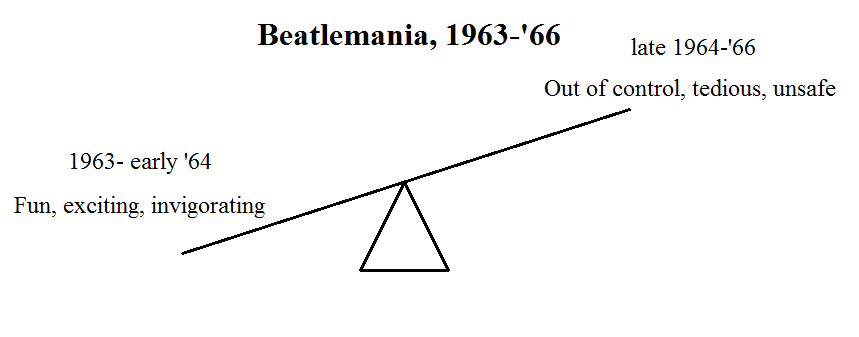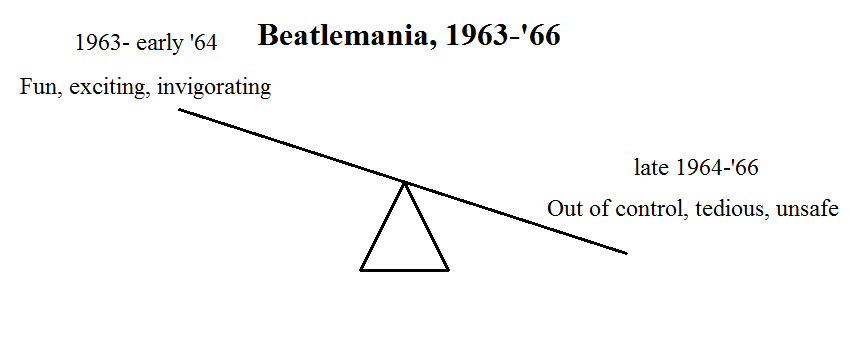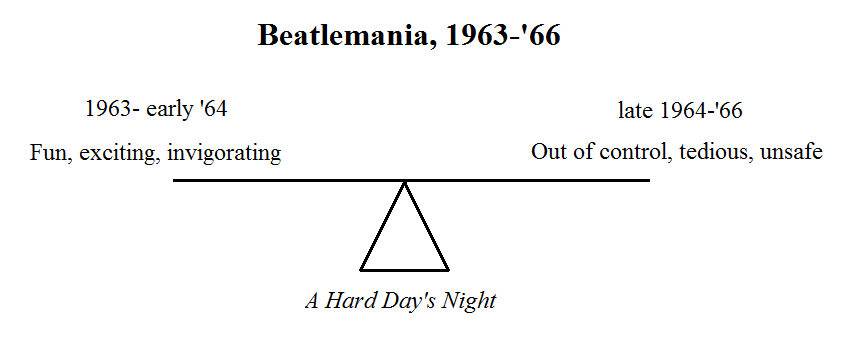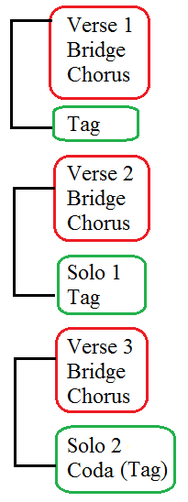|
A Hard Day's Night came at a crucial period in Beatles history. Prior to the film, the enthusiasm of Beatlemania injected the band (and their music) with excitement. Conversely, after the film, Beatlemania outgrew itself and consequently often felt out of control and occasionally dangerous. Perfectly balanced between the two extremes is A Hard Day's Night. The historical significance of A Hard Day's Night, then, is that it captures the Beatles at a pivotal point in their development - a point of unprecedented worldwide fame, but just before that fame turned sour.
0 Comments
Formal structure of [181] "Sun King":
Introduction (Section A) 0:00-0:14 Section A (instrumental) 0:14-0:52 Trans. 0:52-0:58 Section B 0:58-1:24 Section A' (+ vocals) 1:49-2:26 Comments: Once again, the structural analyses of the "Abbey Road Medley" are very different from previous analyses because of the unique structure of the medley as a whole. However, unlike some of the other medley songs, "Sun King" does contain very clear formal articulations. With that in mind, I've chosen to neglect the standard nomenclature of verse, chorus, middle 8, et cetera, and simply use letters (Section A, Section B), which seems better suited to this song specifically. This provides a very nice, clean ternary form: A B A'. The two A sections are practically identical except for the addition of the vocals (the tempo during A' is also a little faster, and the endings are a bit different since they lead to different places). The B section - despite not being a true verse - uses the "third quarter verse structure" that the Beatles used rather frequently in their earlier years ([6] “I Saw Her Standing There”, [31] "A Hard Day's Night", [35] "Things We Said Today", [40] "I Don't Want to Spoil the Party", [42] "No Reply", [43] "Eight Days a Week", [49] "I Need You", [51] "The Night Before", [70] "I'm Looking Through You", [74] "Wait", [75] "You Won't See Me", [172] "Octopus's Garden", and [174] "Her Majesty"). In this case, the first, second, and fourth quarters all use the lyrics "Here comes the sun king", while the third quarter uses the lyrics "Everybody's laughing, everybody's happy". The chords are different, too, but consideration of that will have to wait until my harmonic analysis of this track. Formal structure of [180] "The End":
Intro 0:00-0:12 +vocals 0:12-0:19 Drum Solo 0:19-0:35 Beat 0:35-0:54 Alternating Solos 0:54-1:29 Piano 1:29-1:33 Couplet 1:33-1:47 Coda 1:47-2:04 Comments: Many of the tracks from the "Abbey Road Medley" employ novel formal designs due to the unusual structure of the medley as a whole. "The End" is no exception. There are no verses or choruses, middle 8s or tags. A structural analysis, then, is really more description than anything else in that I have described what happens, but really can't draw any large-scale conclusions from that. I suppose that will have to wait until I finish the analyses of the entire medley, and then put them all together to analyze the structure of the medley as a whole. Formal structure of [179] "Come Together":
Intro/Tag 0:00-0:12 Verse 1 0:12-0:36 Tag 0:36-0:47 Verse 2 0:47-1:10 Chorus 1:10-1:16 Tag 1:16-1:27 Verse 3 1:27-1:51 Chorus 1:51-1:57 Tag 1:57-2:03 Solo 1 (kybd) 2:03-2:14 Solo 2 (gtr) 2:14-2:26 Tag 2:26-2:31 Verse 4 2:31-2:55 Chorus 2:55-3:01 Tag 3:01-3:12 Coda 3:12-4:20 Comments: "Come Together" features an unusual use of the tag in that the distinctive feature is the bass line, which is also heard in the verses (usually tags are independent and structurally cohesive in nature - heard in between sections as a way to connect them). For this reason, the tag might easily be labeled as "beat" instead. The solos are also interesting. "Come Together" is just the 11th Beatles song so far to use multiple solos (after [29b] "Long Tall Sally", [38] "I'm a Loser", [46b] "Everybody's Trying to Be My Baby", [46e] "Honey Don't", [58] "I'm Down", [119] "The Fool on the Hill", [160] "Get Back", [163] "For You Blue", [169] "Old Brown Shoe", and [178] "Maxwell's Silver Hammer"). The solos are heard over the music of the verse (although the drums are much heavier during the solos than during any of the verses). Lastly, at 52 seconds, the coda is the 4th longest the Beatles recorded to date. The only longer codas were those of [137] "Hey Jude" (3:59), [113] "It's All Too Much" (1:44), and [93] "Strawberry Fields Forever" (1:07). When asked by Rolling Stone when the Beatles broke up, John Lennon cited "The Beatles' White Album. Listen - all you experts listen, none of you can hear. Every track is an individual track - there isn't any Beatle music on it. I just say, listen to the White Album. It was John and the band, Paul and the band, George and the Band, like that" (page 88). Using that quote as a springboard, this blog will cite the primary author of each track from The White Album.
Disc 1 Back In The USSR - McCartney Dear Prudence - Lennon Glass Onion - Lennon Ob-La-Di, Ob-La-Da - McCartney Wild Honey Pie - McCartney The Continuing Story Of Bungalow Bill - Lennon While My Guitar Gently Weeps - Harrison Happiness Is A Warm Gun - Lennon Martha My Dear - McCartney I'm So Tired - Lennon Blackbird - McCartney Piggies - Harrison Rocky Raccoon - McCartney Don't Pass Me By - Starkey Why Don't We Do It In The Road? - McCartney I Will - McCartney Julia - Lennon Disc 2 Birthday - McCartney Yer Blues - Lennon Mother Nature's Son - McCartney Everybody's Got Something To Hide Except Me And My Monkey - Lennon Sexy Sadie - Lennon Helter Skelter - McCartney Long, Long, Long - Harrison Revolution 1 - Lennon Honey Pie - McCartney Savoy Truffle - Harrison Cry Baby Cry - Lennon/McCartney Revolution 9 - Lennon (and Ono) Good Night - Lennon Of the 30 songs on the two discs, 12 ½ are Paul's, 12 ½ are John's, 4 are George's, and 1 is Ringo's. CITATIONS The Editors of Rolling Stone. Jonathan Cott and Christine Doudna, ed. The Ballad of John and Yoko. A Rolling Stone Press Book, Dolphin Books Doubleday & Company, Inc., Garden City, NY, 1982. Lennon's obvious response to McCartney's "Can't By Me Love", "You Can't Do That" was the first song recorded explicitly for use in the film A Hard Day's Night. Like his band mate's counterpart, it employs the 12 bar blues, but in G major (rather than the C major of "Can't Buy Me Love") to better suit Lennon's lower vocals. On 24 February 1964, the Beatles recorded 9 takes (only 4 of which were complete) of "You Can't Do That". Conspicuously absent from this sixth take are any non-lead vocals. Where the backing vocals were originally in "Can't Buy Me Love" but then removed before completion, the opposite is true of "You Can't Do That": By the time the song was completed, both McCartney and Harrison's vocals are heard. Lastly, "You Can't Do That" is the first Beatles recording to feature Lennon playing lead guitar (lead was always played by Harrison up to that point).
The first track from the album A Hard Day's Night to be recorded ("This Boy" was recorded the previous 17 October, but despite appearing in the film is absent from the accompanying soundtrack), "Can't Buy Me Love" is, in Paul McCartney's own words, "my attempt to write a bluesy mode” (Miles, Many Years From Now , page 161). And what better way to write a blues song than through the use of the 12 bar blues, the most standard (even cliché) of blues progressions? The song was first recorded on 29 January 1964 at the Parthé Marconi Studios in Paris, France - one of the relatively few Beatles tracks not to be recorded at Abbey Road (then EMI) Studios. The band did four takes. Take 1 has never surfaced, but take 2 shows a very different style than the released version. First, the tonality of the song is C# major - a major second higher pitched than the finished product. This gives McCartney's voice a slightly strained timbre - very bluesy, and quite similar to that which can be heard on "She's a Woman" or "I'm Down". In addition, Harrison and Lennon both add backing vocals starting in the second verse ("Oooooh, love me too", "Oooooh, give to you", et cetera) that again parallels the standard blues idiom. (By the way, I've been searching for a predecessor to this take, something that perhaps inspired or influenced the band's decision to experiment with these backing vocals, but I've had a surprisingly difficult time finding an adequate example. If anybody ever reading this has any suggestions, please do comment!) Despite lasting less than a minute before breaking down, take 3, by contrast, omits the backing vocals entirely. Also, the tonality has been lowered to B major, which significantly reduces the intensity of the lead vocals and instead provides a calmer, more in control timbre. The fourth take splits the difference tonally - it's in C major. This gives McCartney's voice a bit of that bluesy edge, but slightly assuaged so it's not quite so gritty and intense. This fourth take served as the basis for the released version of the song, on to which George Harrison overdubbed a double-tracked guitar solo, and McCartney overdubbed his lead vocals on 25 February. The finished product was then mixed by George Martin on 10 March. CITATIONS
Miles, Barry. Paul McCartney: Many Years from Now. Henry Holt and Company, New York, NY, 1997. Given my negative review of this book, the obvious question is why bother with a timeline based on the book? Especially when I know there are factual errors (like the day John and Paul met). The answer is simply to be thorough. I've done previous such reviews and timelines for other Lennon biographies, and eventually I want to compile all the separate timeline into a single, exhaustive chronology. When I do that, I will compare and contrast various authors' accounts. Any factual errors will be weeded out then. But for right now, my goal is just to be thorough in my research and document all of my sources. Moreover, mistakes are often the best way to learn. If I find errors in this timeline, I will be more likely to remember the right date by correcting these errors.
1966.11.? John and Yoko meet (p. 155) 1968.06.15 John and Yoko plant acorns for peace (p. 67, 159) 1968.06.18 In His Own Write premiered (p. 159) 1968.07.01 Opening of John's art exhibit (p. 159) 1968.10.18 Drug bust (p. 69, 161) 1968.11.08 John and Yoko run an ad about the "Peace Ship" (p. 161) 1968.11.09 Two Virgins album released (p. 161) 1968.11.21 Yoko's first miscarriage (p. 161) 1968.12.18 John and Yoko perform "Bagism" at Royal Albert Hall (p. 161) 1968.12 Rock 'n' Roll Circus filmed (p. 162) 1968.12.end production of film Rape (p.161) 1969.03.07 John and Yoko perform "Cambridge 1969" (p. 162) 1969.03.20 John and Yoko marry in Gibraltar (p. 73, 78, 162) 1969.03.26 John and Yoko's "Bed-In for Peace" (p. 73, 163) 1969.04.01 John and Yoko perform "Bagism" following the premiere of their film Rape in Austria. John also announced sending two acorns to the leaders of each country for peace (p. 163) 1969.04.26 John changes his middle name from Winston to Ono (p. 163) 1969.05.01 Album Life with the Lions released [in UK?] (p. 163-64) 1969.05.20 "The Ballad of John and Yoko" released [in UK?] (p. 164) 1969.05.26 Album Life with the Lions released in US (p. 164) 1969.06.16 "The Ballad of John and Yoko" released in US (p. 78, 164) 1969.07.end Car crash (p. 164) 1969.07.28 Single "Give Peave a Chance"/"Remember Love" released in UK and US (p.79, 164) 1969.09.? Wedding Album released in UK (p. 164), "An Evening With John and Yoko" held at the New Cinema Club in London with a showing of 4 Lennon/Ono films (p. 165) 1969.09.13 Rock and Roll Revival in Toronto (p. 165) 1969.10.20 Wedding Album released in US (p. 165) 1969.12.? Album Live Peace in Toronto released in UK (p. 166) 1969.12.15 Album Live Peace in Toronto released in US (p. 80, 166) 1970.09.22 John and Yoko appear as guests on the Dick Cavett Show (p. 167) 1970.12.09 Album John Lennon/Plastic Ono Band released in UK (p. 81, 167) 1971.05.15 The Filmaker's Fortnight Festival in Cannes, Fance, showed two John and Yoko films: Apotheosis (Balloon) and Fly (p. 168) 1971.06.06 John and Yoko perform with Frank Zappa (p. 168) 1972.01.13 John and Yoko appear as guests on the David Frost Show (p. 168) 1972.02.21-25 John and Yoko co-host the Mike Douglas Show (p. 168) 1972.04.04 John and Yoko appear as guests on the Dick Cavett Show; television special John and Yoko in Syracuse, N.Y. broadcast (p. 169) CITAITONS Garbarini, Vic and Brian Cullman with Barbara Graustark. Strawberry Fields Forever: John Lennon Remembered. Bantam, New York, NY, 1980. Formal structure of [178] "Maxwell's Silver Hammer": Verse 1 0:00-0:29 Bridge 0:29-0:37 Chorus 0:37-0:51 Tag 0:51-0:59 Verse 2 0:59-1:28 Bridge 1:28-1:35 Chorus 1:35-1:50 Solo 1 (v) 1:50-2:04 Tag 2:04-2:12 Verse 3 2:12-2:41 Bridge 2:41-2:48 Chorus 2:48-3:03 Solo 2 (v) 3:03-3:17 Coda (tag) 3:17-3:27 Comments: With the exception of the lack of introduction, this is pretty standard. The verses, bridges, choruses, and tags all function in textbook manner. The only thing slightly unusual is the use of multiple solos - something the Beatles had done just 9 times previously in [29b] "Long Tall Sally", [38] "I'm a Loser", [46b] "Everybody's Trying to Be My Baby", [46e] "Honey Don't", [58] "I'm Down", [119] "The Fool on the Hill", [160] "Get Back", [163] "For You Blue", and [169] "Old Brown Shoe" - both of which employ the verses' music, sans vocals. The macro-scale formal design of the song can be broken down quite neatly into three nearly identical parts (indicated in the graphic below with black brackets), each of which can be further broken down into two parts (the red and green squares). Notice that the second and third black brackets are structurally identical, but that the first is "missing" a solo.
Formal structure of [177] "Here Comes The Sun":
Intro 0:00-0:14 guitar 0:00-0:07 + keyboard 0:07-0:14 Chorus 0:14-0:27 Verse 1 0:27-0:43 Chorus 0:43-0:55 Instrumental ext. 0:55-0:59 Verse 2 0:59-1:14 Chorus 1:14-1:27 Trans. 1:27-1:31 Middle 8 1:31-2:12 Verse 3 2:12-2:27 Chorus 2:27-2:39 Ext. 2:39-2:52 Ext. 2:52-2:59 Coda (M8) 2:59-3:05 Comments: "Here Comes the Sun" is the first in a while to use a 2-part intro, with the solo guitar being heard first, followed by the keyboard. This was a very common tactic in early Beatles recordings, but has become less common in the later recordings. The band used 2-part introductions previously in [6b] "A Taste Of Honey", [11] "Thank You Girl", [17] "Little Child", [14b] "Roll Over Beethoven", [24] "You Can't Do That", [31b] "Matchbox", [37] "Baby's in Black", [38b] "Mr. Moonlight", [45] "I Feel Fine", [46e] "Honey Don't", [47] "Ticket to Ride", [62] "Run For Your Life", [63] "Norwegian Wood (This Bird Has Flown)", [66] "If I Needed Someone", [77] "Tomorrow Never Knows", [79] "Love You To", [81] "Paperback Writer", [89] "I Want to Tell You", [92] "She Said She Said", [102] "Lovely Rita", [104] "Getting Better", [105] "Within You Without You", [110] "Baby, You're a Rich Man", [114] "All You Need Is Love", [125] "Revolution 1", [126] "Don't Pass Me By", [130] "Good Night", [131] "Ob-la-di Ob-la-da", [134] "Helter Skelter", [138] "Mother Nature's Son", and [172] "Octopus's Garden". The middle 8 consists of the same six-measure phrase repeated 5 times (i.e. heard a total of 6 times, the first of which omits the vocals) followed by a transition that both climaxes the song and leads back to the third verse. One thing I have occasionally noticed about the formal structure of Beatles songs is the way they climax about two thirds of the way through, followed by a return to the verse. I have often wondered about a connection between that and the climax of classical Sonata Form, which similarly climaxes about two thirds of the way through when the development section segues to the recapitulation. There's more to be written on this notion, but that will be an entire blog on its own rather than part of this one. Lastly, the final chorus features not one, but two extensions that help propel the song to it's conclusion. |
Beatles BlogThis blog is a workshop for developing my analyses of The Beatles' music. Categories
All
Archives
May 2019
|




 RSS Feed
RSS Feed
